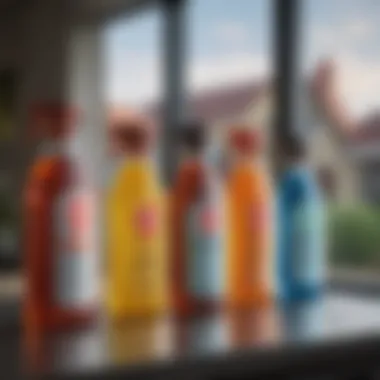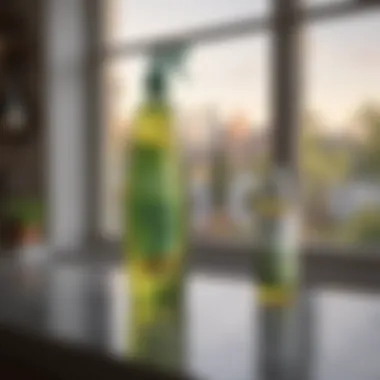The Best Liquid for Spotless Window Cleaning


Intro
When it comes to maintaining a clear view through your windows, the choice of cleaning liquid cannot be understated. Many people wonder what the best solution is for achieving that streak-free, inviting shine. Cleaning your windows well is not merely about aesthetics; it influences light entry and overall home ambiance. In this analysis, we will explore various liquids used for window cleaning, examining their effectiveness, safety standards, and environmental implications.
This journey will guide you through conventional commercial products, popular homemade solutions, and the most accepted practices in the industry. Not only will we evaluate the performance of these liquids, but we will also consider cost-effectiveness and sustainability. By focusing on key aspects, this article aims to empower homeowners and professionals alike to make educated decisions when selecting their window cleaning solution.
Understanding Window Cleaning Fundamentals
Window cleaning is more than just making your home look better. It is a vital part of maintaining the longevity of windows and enhancing the overall aesthetic of spaces. Understanding the fundamentals of window cleaning involves grasping what makes a solution effective and knowing how to implement it correctly. This ensures a streak-free finish while minimizing potential damages to the window surface. A proper approach can save both time and resources, making it essential for any home or facility manager.
The Science Behind Cleaning Solutions
Cleaning solutions work based on chemical interactions. Effective cleaning solutions often contain surfactants that help break down grime and dirt. Surfactants reduce the surface tension of water, allowing it to spread and penetrate dirt, making it easier to wipe away. Moreover, solutions may also include solvents that help dissolve tougher stains, such as oil or grease. Understanding the science behind these chemical properties is crucial for selecting the right cleaning product.
Parameters for Effective Window Cleaning
pH Levels
pH levels indicate how acidic or alkaline a cleaning solution is. Most glass cleaning products have a pH that hovers around neutral. This is beneficial because high acidity can damage glass over time. A neutral pH ensures the cleaning solution does not harm the window surface while effectively removing contaminants. Solutions that maintain a balanced pH are favorable as they achieve cleaning effectiveness without causing wear.
Surface Tension
Surface tension involves the cohesive forces at the surface of a liquid. When it comes to window cleaning, lower surface tension in solutions enables water to spread more evenly. This helps to prevent pools of liquid that can leave streaks once dried. Products designed to reduce surface tension facilitate better adherence to glass, making them more effective in the cleaning process. Solutions with optimized surface tension properties result in minimal streaking.
Residue and Streak Formation
Residue is left behind when a cleaning solution dries on glass. Streak formation occurs when certain substances in the product do not evaporate completely or leave a film on the surface. It is crucial to choose a cleaning solution that leaves no trace after drying. Products lacking in certain additives lessen the chance for streaks. An ideal window cleaning solution should guarantee a crystal-clear finish and avoid any confusing side effects.
Commercial Window Cleaning Solutions
Commercial window cleaning solutions play a vital role in achieving clean and streak-free windows. These products are designed specifically for the rigors of frequent use in both domestic and commercial settings. Their formulation often includes a variety of cleaning agents that enhance efficiency and yield results that are difficult to replicate with homemade solutions. Furthermore, understanding these products helps users select the right solutions tailored to their specific needs. As such, they can enhance not only the aesthetics of the windows but also their longevity and clarity.
Overview of Popular Cleaning Products
Glass Cleaners
Glass cleaners are a staple in window cleaning, renowned for their effectiveness and ease of use. These products typically feature ammonia or alcohol as their key ingredient, which aids in breaking down grime and residues effectively. One prominent characteristic of glass cleaners is their ability to evaporate quickly, leaving behind minimal streaks. This rapid evaporation is crucial as it allows users to clean and polish surfaces swiftly, especially important for businesses or homes where time is of the essence. However, while glass cleaners provide an excellent shine, their reliance on certain chemicals can be a double-edged sword. The strong fragrances and potentially irritating substances raise some concerns regarding indoor air quality and safety.
Multi-Surface Cleaners
Multi-surface cleaners are designed to be versatile, allowing users to clean various surfaces beyond just glass. This characteristic makes them a beneficial choice for those who seek an all-in-one solution for different materials, such as wood, metal, and tile. The advantage of these cleaners lies in their formulation, which often includes biodegradable ingredients, appealing to environmentally conscious consumers. Nonetheless, the effectiveness of multi-surface cleaners on glass may not match that of dedicated glass cleaners. Streaks can sometimes appear if not rinsed properly, which is a consideration to keep in mind when selecting cleaning products.
Specialty Window Cleaners
Specialty window cleaners target specific cleaning challenges, such as removing hard water spots or industrial soils. They are often formulated with specialized agents that enhance their cleaning power, making them a popular choice among professionals. One key characteristic is their ability to address stubborn messes that standard cleaners may struggle with. For instance, some products might be designed for high-rise buildings, with foaming agents that cling to vertical surfaces, ensuring thorough cleaning. However, while these cleaners can produce exceptional results, they may come with higher costs and may require more safety precautions due to their powerful formulations.
Evaluating Effectiveness and Ingredients
A rigorous evaluation of the effectiveness and ingredients in commercial cleaning solutions is essential. This examination allows users to determine what suits their needs, balancing cleaning performance with safety and environmental impact. Thus, this segment focuses on assessing various products by reviewing their ingredient composition and how effectively they meet cleaning demands.
Safety Considerations of Commercial Solutions
Toxic Chemicals
Toxic chemicals in commercial cleaning products pose significant health risks, a factor that must be considered by users. Many traditional cleaning agents contain substances that can be harmful when inhaled or when they come into contact with skin. For instance, chemicals such as butyl cellosolve or formaldehyde may be effective in cleaning but can lead to respiratory issues or skin irritation over time. It is crucial to read labels and understand the risks associated with such ingredients to make informed choices about which products to use regularly.
Fumes and Skin Irritation
Fumes from commercial window cleaning solutions can lead to immediate discomfort and long-term health issues. Many of these products emit strong odors, which may irritate sensitive individuals. Moreover, prolonged exposure to cleaning solutions can result in skin irritation, making it essential to wear protective gear when handling these products. Although the cleaning results may be impressive, the potential negative impact on health cannot be overlooked. Therefore, evaluating the safety profile of any cleaning product before use is a wise course of action.
Homemade Window Cleaning Remedies
Homemade window cleaning remedies offer a viable alternative to commercial solutions. They attract interest due to their affordability and simplicity. Many consumers are increasingly aware of the harmful chemicals present in some store-bought products. The option to utilize everyday household ingredients empowers individuals to create effective cleaning solutions. This section explores various common ingredients and how they can be used for window cleaning.
Common Household Ingredients


Vinegar
Vinegar is often the go-to choice for homemade window cleaning solutions. Its key characteristic is its acetic acid content, which effectively cuts through grime and grease. The basic formula typically involves mixing equal parts of vinegar and water. This mix is a beneficial choice for many because it is eco-friendly and cost-effective. One unique feature of vinegar is its ability to eliminate odors, making it useful in cleaning beyond just windows.
Advantages:
- Non-toxic and safe for the environment
- Effective at removing hard water spots and streaks
- Easily available in most kitchens
Disadvantages:
- The strong smell can be unpleasant for some individuals
- Might not be suitable for certain types of window coatings.
Baking Soda
Baking soda serves as another popular ingredient for window cleaning. It acts as a gentle abrasive, making it useful for scrubbing without scratching the surface. A paste made with baking soda and water can tackle tougher stains. It adds a sparkle to glass surfaces. The key characteristic of baking soda is its ability to neutralize odors, which can be a bonus during cleaning.
Advantages:
- Non-abrasive and safe for cleaning delicate surfaces
- Cost-effective and versatile in various cleaning tasks
Disadvantages:
- Requires a bit of effort to make a paste and scrub manually
- Can leave a residue if not thoroughly rinsed.
Lemon Juice
Lemon juice is valuable due to its natural acidity. It effectively removes grease and cuts through dirt. A mixture of lemon juice and water works well for window cleaning. Its fresh scent adds an appealing aspect to the cleaning process. One unique feature of lemon juice is its antibacterial properties, which can also help in maintaining overall cleanliness.
Advantages:
- Pleasant scent that can improve the cleaning experience
- Natural disinfectant properties
Disadvantages:
- May cause irritation on skin if not handled carefully
- Less effective on heavy buildup compared to stronger solutions.
Dish Soap
Dish soap functions effectively in window cleaning as well. Many formulations are gentle yet powerful enough to cut through dirt and grease. It works best when diluted in water. The key characteristic of dish soap is its surfactant properties, which help in reducing surface tension. This makes it easier for water to spread and clean surfaces.
Advantages:
- Readily available in most households
- Very effective in cutting through greasy residues
Disadvantages:
- Can require rinsing to prevent streaks if used in excess
- Some brands may contain harsh chemicals if not chosen wisely.
Formulating Effective Cleaning Solutions
Formulating effective cleaning solutions with these ingredients can elevate the window cleaning experience. One can experiment with ratios to find the most effective combination that suits specific needs. Combining vinegar and lemon juice may enhance cleaning power and leave a pleasant scent. Meanwhile, incorporating baking soda can address stubborn stains effectively.
Assessing the Pros and Cons of DIY Solutions
Cost-Effectiveness
Cost-effectiveness is a significant aspect for consumers considering DIY cleaning solutions. Using household ingredients is often much cheaper than buying commercial products. The ingredients are usually available at home, which means no additional expenses. This fosters a trend toward sustainable cleaning practices.
Advantages:
- Significant savings can be realized in the long term
- Simple to make, requiring minimal effort
Disadvantages:
- Some users may find it less convenient than buying ready-made solutions
Environmental Impact


Environmental impact is increasingly important for consumers today. Homemade solutions generally have a lower environmental footprint. Most household ingredients are biodegradable and free of harsh chemicals. This makes them less harmful to the ecosystem when they are washed down the drain.
Advantages:
- Eco-friendly, reducing pollution levels
- Promotes sustainability by reducing reliance on commercial products
Disadvantages:
- Effectiveness may vary compared to commercial formulas
- Might not be suitable for heavy-duty cleaning tasks.
Cleaning Performance
Cleaning performance remains a priority for users. While DIY solutions can be effective, they may not match the performance of some commercial products. Nevertheless, many users find that a well-formulated homemade solution can deliver satisfactory results for regular cleaning.
Advantages:
- Satisfaction from using homemade solutions can be rewarding
- Users can customize ingredients to their preferences
Disadvantages:
- Results may vary based on the user’s approach
- Some stains or residues may require stronger, commercial solutions for proper removal.
Sustainable Window Cleaning Practices
Sustainable window cleaning practices are essential in today's environmentally conscious society. By engaging with eco-friendly practices, individuals and organizations can minimize their environmental footprint. This section will explore the significance of sustainable elements, focusing on eco-friendly solutions and the role of water in window cleaning. The benefits often include reduced chemical use, less pollution, and promoting a healthier ecosystem.
Harnessing Eco-Friendly Solutions
Plant-Based Cleaners
Plant-based cleaners are a focal point in the conversation about sustainable window cleaning. They utilize natural ingredients derived from plants instead of synthetic chemicals. This feature makes plant-based cleaners an appealing and safe option for both users and the environment.
Key characteristics of these cleaners include their biodegradable nature and reduced toxicity. Many users appreciate these cleaners because they do not produce harsh fumes, making them suitable for indoor cleaning. However, their effectiveness can occasionally be less than that of conventional cleaners, particularly in tough stain removal. Thus, while they are a great choice for general cleaning, users may need to test their efficacy for specific tough jobs.
Biodegradable Components
Biodegradable components are vital in many cleaning products today, including those aimed at window cleaning. These ingredients break down naturally over time, reducing long-term environmental impact. This feature is essential for cleaners that one might wash down drains, as it helps in minimizing water pollution.
The main attraction of biodegradable components is their low environmental toll compared to traditional chemical alternatives. They cater to a growing demographic that values sustainability in purchase decisions. However, it is important to check product labels, as not all products labeled eco-friendly are entirely free from harmful substances. Therefore, awareness is necessary when choosing these products.
The Role of Water in Window Cleaning
Water serves as a fundamental element in the window cleaning process. Its role goes beyond mere liquid support; it directly affects the efficiency of the cleaning solution. Notably, the quality of water can significantly influence the final result of the cleaning process.
Water Quality
Water quality is a critical factor in window cleaning. Clean, soft water is better as it minimizes streaks and spots that hard water may leave on surfaces. Many homeowners overlook this, but water impurities can profoundly affect how well cleaning solutions perform.
Using distilled or filtered water can enhance the performance of various cleaners, ensuring a clearer and streak-free finish. This reality places emphasis on the importance of checking the source of your water before cleaning. While tap water may be readily available, it is not always the most effective choice.
Water Conservation Techniques
Water conservation techniques are increasingly relevant in the context of sustainable window cleaning practices. Methods such as using spray bottles instead of running water can significantly reduce waste. Implementing these techniques contributes to overall water conservation, something all individuals should consider.
Key conservation methods include:
- Recycling water from other cleaning processes.
- Using focused spray to minimize large water usage.
- Timing cleaning tasks strategically to align with weather conditions, reducing evaporation.
By adopting these techniques, not only is the water usage lowered, but users also cultivate a responsible approach to resource management in their cleaning routines.
Practicing sustainable window cleaning is not just about the products used; it is also about the broader approach to minimize environmental impact.
Techniques for Optimal Window Cleaning
Effective window cleaning goes beyond selecting the right liquid. The techniques used to apply these liquids play a crucial role in achieving a streak-free shine. Understanding these techniques can greatly enhance the results of both commercial and homemade cleaning solutions. Selecting the appropriate tools and practicing the right methods can save time, reduce material waste, and ensure a cleaner finish.


Tools and Equipment Required
Choosing the right tools is essential for optimal window cleaning. Each tool serves a specific purpose and can significantly influence the cleanliness of the surface.
Squeegees
Squeegees are vital for removing excess liquid from windows. The key characteristic of a squeegee is its rubber blade, which allows for even distribution and removal of cleaning solution. This tool is widely regarded as beneficial due to its efficiency in preventing streaks, making it a popular choice among both professionals and homeowners.
Its unique feature lies in its ability to adapt to various window shapes and sizes. While it is highly effective, improper technique can lead to inadequate cleaning and potential markings. Therefore, mastering its use is important for optimal results.
Microfiber Cloths
Microfiber cloths are essential for finishing touches in window cleaning. A major advantage of these cloths is their highly absorbent nature. This absorbency ensures that the surface dries without residual moisture that can lead to spotting or streaking. Additionally, they are soft and less abrasive, making them safe for delicate surfaces. Their unique feature is their electrostatic properties, which trap dust and dirt effectively. However, it's important to keep them clean; otherwise, they can inadvertently scratch the glass.
Extension Poles
Extension poles facilitate access to high or hard-to-reach windows. The main benefit of using extension poles is their extendability, reducing the need for ladders and thereby improving safety during cleaning. They are often lightweight but sturdy, making them easy to maneuver. A unique feature of some extension poles is the interchangeable heads, allowing users to switch between tools, such as squeegees or brushes, based on the cleaning needs. On the downside, it can be challenging to control precision with longer poles, which may affect the cleaning quality in tight spaces.
Best Practices for Application
To maximize effectiveness, certain best practices should be followed during the application of the cleaning solutions.
- Work from top to bottom: This prevents dirty water from running down onto clean areas.
- Use the right amount of liquid: Excessive liquid can lead to streaks and longer drying times.
- Maintain tools regularly: Clean squeegees and microfiber cloths are essential for optimal performance.
By integrating these tools and techniques into your window cleaning routine, you will find that achieving impeccable results is both effective and efficient.
Evaluating User Preferences
Understanding user preferences is crucial in selecting the appropriate liquid for window cleaning. With countless options available, it is important to consider how effective and safe a product is, as well as its environmental impact. This section aims to highlight the specific elements that influence consumer choices and preferences when it comes to cleaning solutions.
User preferences can vary greatly depending on individual needs. For instance, a homeowner with small children may prioritize non-toxic ingredients over price or brand reputation. Similarly, professional cleaners might look for products that offer superior performance for large jobs. By recognizing these factors, manufacturers can cater to specific demographics effectively.
In addition to safety, consumers are increasingly concerned about the environmental aspect of products they use. Many prefer eco-friendly options that minimize harm to the planet. These considerations play a substantial role in shaping market trends and innovation in window cleaning solutions.
Consumer Feedback on Different Solutions
User feedback provides critical insights into the effectiveness of various cleaning solutions. Reviews and testimonials shed light on practical experiences that users have had with different products. Factors like ease of use, convenience, and actual cleaning performance are key elements that consumers often share in their feedback.
Online platforms, such as Reddit or Facebook, often have discussions about user experiences concerning specific brands. These exchanges are valuable for potential buyers, as they can learn about the pros and cons before making a purchase. Products that receive consistently positive feedback tend to build a loyal customer base, while those that don’t may see less market success.
Very often, people gravitate towards window cleaning solutions that are community-approved. For example, a popular product might be praised for its streak-free finish. In contrast, a product that was supposed to be eco-friendly may be criticized for leaving a residue.
Market Trends and Innovations
The cleaning market is continuously evolving, particularly in the area of window cleaning solutions. New innovations aim to improve cleaning efficacy and user convenience, aligning with preferences shown in consumer feedback.
Trends indicate a clear shift toward environmentally friendly products. Companies are now focusing on developing plant-based cleaners which are safer for both users and the environment. Furthermore, biodegradable ingredients are gaining traction as more consumers seek sustainable options.
In addition to this, technology plays a role in shaping market trends. Innovations such as spray bottles that deliver fine mist or products that work well with specific tools, like microfibre cloths, can enhance the cleaning experience. As competition increases, brands focus on differentiating themselves by offering unique features or formulations that attract modern consumers.
As the market adapts, it is essential for consumers to engage with new information. Recognizing user preferences and market innovations can lead to better decision-making when selecting window cleaning solutions, ensuring that both efficacy and sustainability are not compromised.
End: Making an Informed Choice
The ability to choose the right liquid for window cleaning greatly impacts both the outcome of the cleaning process and the longevity of the surfaces being cleaned. This article has provided a comprehensive overview, demonstrating how various cleaning solutions behave and the effects they can create. Homeowners and professionals alike benefit from understanding the different properties of cleaning liquids.
When selecting a window cleaning solution, considering specific elements such as effectiveness, safety, and environmental impact is crucial. It's not merely about achieving a streak-free shine; it’s also about ensuring that the chosen product aligns with one's care for their environment and the health of residents or workers. Cleaning tasks can often involve exposure to toxic chemicals. A cleaner without harmful fumes can improve indoor air quality. Therefore, knowledge and awareness in this area can enhance living conditions.
In summary, making an informed choice is about balancing performance with safety and sustainability. Having a detailed understanding allows for smarter selections that serve the needs of the task efficiently.
Summation of Key Findings
- Effectiveness of Solutions: Various products have been analyzed, showcasing that not all cleaners perform equally. Commercial glass cleaners often deliver excellent results, however, homemade remedies can also be surprisingly effective, depending on the formulation used.
- Safety Implications: The discussion regarding toxic ingredients emphasizes the need to prioritize cleaning solutions with fewer harmful substances. Products that carry labels indicating they are eco-friendly or non-toxic should be heavily weighed in decisions.
- Environmental Considerations: This article elucidated the importance of sustainable practices. Consumers increasingly favor products that are biodegradable and come from renewable resources.
- User Preferences: Trends in market data show an increasing demand for versatile cleaning solutions that can cater to various surface types while maintaining effectiveness and safety.
"Choosing the right window cleaning liquid involves balancing different factors. It's not just about performance; safety and environmental impact are equally significant."
Final Recommendations
When selecting a window cleaning liquid, the following guidelines can help achieve the best outcomes:
- Choose Products Wisely: Select commercially available cleaners acknowledged for their effectiveness, such as Windex or Invisible Glass, but do not overlook the power of vinegar-based or citric acid solutions as effective home alternatives.
- Read Labels Carefully: Ensure that the product offers clear information about ingredients and potential effects. Look for certifications indicating non-toxicity or eco-friendliness.
- Combine Techniques: In many cases, using a dual approach works best. For example, a commercial cleaner can be complemented with homemade vinegar solutions for tough spots.
- Invest in Good Tools: While the liquid is important, don't neglect the impact of the tools used. A reliable squeegee or microfiber cloth can enhance any cleaning solution’s efficiency.



